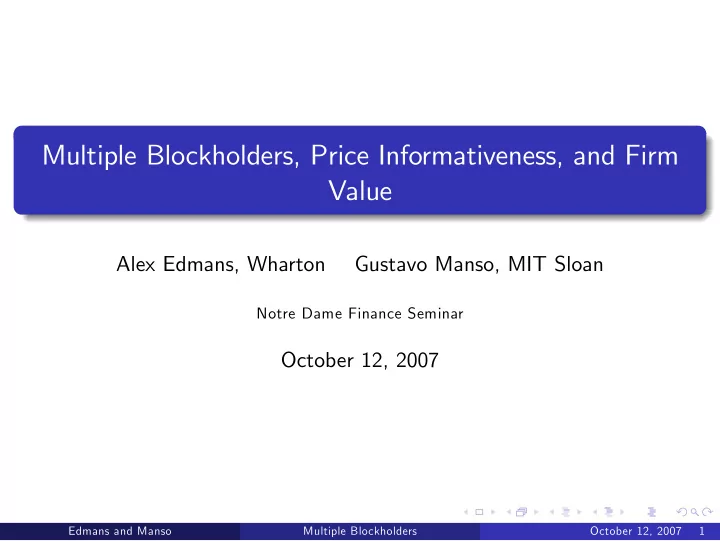

Multiple Blockholders, Price Informativeness, and Firm Value Alex Edmans, Wharton Gustavo Manso, MIT Sloan Notre Dame Finance Seminar October 12, 2007 Edmans and Manso Multiple Blockholders October 12, 2007 1
Introduction What is the optimal blockholder structure that maximizes the e¤ectiveness of corporate governance? Traditional view: blockholders govern through intervention (“voice”) – Few, concentrated stakes are optimal to minimize free-rider problems and maximize intervention incentives – But most …rms have multiple small blockholders (Zwiebel (1995), Barca and Becht (2001), Faccio and Lang (2002), Maury and Pajuste (2005), Holderness (2007)) This paper provides a potential justi…cation for multiple blockholder structures Edmans and Manso Multiple Blockholders October 12, 2007 2
Introduction (cont’d) MBs increase the e¤ectiveness of a second governance mechanism: trading (“exit”) – Managerial e¤ort improves fundamental value, but manager is paid according to stock price – Trading causes prices to re‡ect fundamental value, rewarding e¤ort ex post Dynamic consistency issues: once e¤ort has been exerted, blockholders are only concerned with maximizing trading pro…ts – A single blockholder will strategically limit her order, reducing price informativeness – Multiple blockholders trade competitively, as in a Cournot oligopoly * Here, co-ordination problems help , by serving as a commitment device to reward the manager ex post Edmans and Manso Multiple Blockholders October 12, 2007 3
Related Literature Zwiebel (1995), Bennedsen and Wolfenzon (2000): control contest motivations for MBs Di¤erences with Edmans (2007): – Considers both “voice” and “exit”, and the trade-o¤s between them – Fundamental agency problem is shirking, not myopia – Derives multiple blockholders as an optimal structure, and analyzes the determinants of the e¢cient number Edmans and Manso Multiple Blockholders October 12, 2007 4
The Model Manager owns α , I blockholders collectively own β (i.e. β / I each) t = 1: manager exerts e¤ort a , each blockholder exerts e¤ort b i (all at unit cost) – Firm value: e v = φ a log a + φ b log ∑ i b i + e η – a is private (critical), b i is public (non-critical) t = 2: trading by blockholders and liquidity investors – Each blockholder observes e v perfectly and demands x i ( e v ) ε � N ( 0 , σ 2 – Noise traders demand e ε ) – Market maker observes order ‡ow e y = ∑ i e x i + e ε and sets e p = E [ e v j e y ] Manager maximizes α e p � a Blockholder maximizes individual trading pro…t + value of shares - cost of e¤ort Edmans and Manso Multiple Blockholders October 12, 2007 5
The Trading Stage Proceed by backward induction: take a and b i as given Unique linear equilibrium is symmetric: x i ( e v ) = γ ( e v � φ a log a � φ b log ∑ i b i ) 8 i p ( e y ) = φ a log a + φ b log ∑ i b i + λ e y , 1 Each blockholder’s trading pro…ts are p I ( I + 1 ) σ η σ ε 1 Price informativeness is negatively related to σ 1 � Var ( e v j ˜ p ) = I + 1 σ η Edmans and Manso Multiple Blockholders October 12, 2007 6
The Action Stage Optimal actions: � � I a = φ a α I + 1 � 1 � 2 b i = φ b β I � 1 � ∑ i b i = φ b β . I ∑ i b i is decreasing in I – Blockholders exert positive externalities on the …rm , which they do not consider – “Too little” intervention: standard free-rider problem Edmans and Manso Multiple Blockholders October 12, 2007 7
The Action Stage (cont’d) a is increasing in I – Blockholders exert negative externalities on each other , which they do not consider – “Too much” trading * Reduces informed trading pro…ts, hurting blockholders in aggregate * Increases price informativeness – But …rm value does not depend on informed trading pro…ts, but instead price informativeness * Co-ordination problems commit to “too much” trading, creating a dynamically consistent reward mechanism for managerial e¤ort Edmans and Manso Multiple Blockholders October 12, 2007 8
The Optimal Number of Blockholders h i Optimum for …rm value: I � = max 1 , φ a � φ b φ b I � depends on trade-o¤ between e¤ect on blockholder e¤ort (“voice”) and managerial e¤ort (via “exit”) – φ b depends on nature of blockholders’ expertise * High if forward-looking (“prospective”) information, e.g. venture capital * Low if backward-looking (“retrospective”) information, e.g. rentier capital * High if strong control rights (holding β constant), e.g. foreign blockholders – φ a depends on manager’s scope to improve …rm value * High in growth industries, low in regulated industries – Weak governance increases both φ a and φ b and thus has ambiguous e¤ects Edmans and Manso Multiple Blockholders October 12, 2007 9
The Optimal Number of Blockholders (cont’d) Social optimum considers: – Cost of managerial e¤ort (reducing I � soc relative to I � ) – Cost of blockholder e¤ort (increasing I � soc relative to I � ) Private optimum considers: – β % of increase in …rm value – Cost of blockholder e¤ort (increasing I � priv relative to I � ) – Informed trading pro…ts (reducing I � priv relative to I � ) Edmans and Manso Multiple Blockholders October 12, 2007 10
In Progress ... E¤ect of information asymmetry – Likely to reduce potency of exit and thus I � E¤ect of liquidity – Currently, σ ε is irrelevant, but may become signi…cant if costly information acquisition – Likely to increase potency of exit and thus I � Asymmetric blockholders Further suggestions? Edmans and Manso Multiple Blockholders October 12, 2007 11
Recommend
More recommend